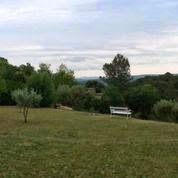The parterre, one of the first things you come across, is not made of box but a dwarf form of myrtle (Myrtis communis). The parterre is filled with herbaceous plants (agapanthes, foxgloves, peonies, roses and others. One particular plant,
everyone was wondering about - for sale last year in Cotignac market (Tuesday) in early summer, is Dicliptera suberecta (also known as Jacobinia or Justicia). Dicliptera is its new name according to the RHS. The leaves are whitish-grey, which you can see if you look carefully, not those other green leaves, they belong to a different plant.
From the front of the house the view is of an undulating lawn, with in the foreground, clipped evergreens. To break up the formality, some low shrubs and roses (Iceberg). The evergreens they used are all well suited to the climate:
Eleagnus x ebbengui; Lavandula; Phillyrea angustifolia; Photinia x fraseri 'Red Robin'; Pittosporum tobira; Santolina chamaecyparissus (grey-leaved variety); Santolina rosmarinifolia (green-leaved variety); Viburnum tinus.
They've been kept low not to interfere with the distant view of the Maures.
All around the house there are interesting corners with curiosa, chairs and tables.
Walking on,
you come to the pool area, with another seating arrangement.
All very tastefully done.
At the entrance to the pool are two pots with Solanum crispum 'Glasnevin'.
At the end of the visit our hostess served us a fruit cocktail (made up with frozen packet of fruits of the forest; white wine; sparkling water and grenadine), rather fresh and delicious and in addition some cakes.
On we went to Rosaline and Bonno's house, a lovely old mas
with a bassin, on the plain just above the rock face of Cotignac for our picnic lunch. We were with 30 having lunch, everybody brought a dish, all very delicious.
We were very lucky with the weather, a few drops of rain, but nothing to speak off. The setting was lovely, the sound of the waterfall, which runs just at the end of the garden, accompanied us all during lunch.
There was enough time to walk around the garden and as usual have a good chat, it is amazing how time flies.
We were 20 for the afternoon visit of Cotignac.
Met at the Tourist Office by the tourist guide we made our way to Cours Gambetta, at the end of the Cours is 'Fountaine de Quatre Saisons' dating back to 1810 with four heads carrying on top; spring - flowers; summer - a sheaf of wheat; autumn - grapes; winter - head is covered with a scarf.
On to St. Peter's Church dating back to 1266. Initially the population of Cotignac lived in the plain above Cotignac and used St. Martin's chapel to worship. There were a lot of robbers and other undesirable elements present at the time, people felt unsafe and some of them went to live in the caves, others settled in present day Cotignac.
Cotignac is a place of pilgrimage. First of all the church of 'Our Lady of Grace' on Mont Verdaille. The story goes that in 1519, the Virgin Mary appeared to a woodcutter, Jean de la Baume and gave him the message to tell the clergy to build a church on Mont Verdaille. If this was done the Virgin Mary would grant a number of blessings and favours to those who called upon her in that place. In 1637 after 22 years of marriage the king, Louis XIII, and his wife, Anne of Austria, were still childless. Through a priest in Paris who had received a holy message, she was told to pray for a child in Cotignac. She came to Cotignac and 9 months later Louis XIV was born. Louis XIV actually came with his mother to Cotignac to pay homage.
The second place of pilgrimage is Monastery St. Joseph. In 1660 on Mont Bessillon, Joseph appeared to a thirsty shepard. A spring started to flow from a rock nearby, it still flows today. A monastery was built and it is seen as a special place of worship.
We followed our walk through Grand Rue with its art galleries and small shops. Around the middle of the street we were told to look up and right underneath the roof there were 3 'Cariatides', put there by a rich merchant wanting to show off his wealth.
Via the Place the Mairie we climbed up, first passed 'the do it yourself oil mill' where in former times you could press your own oil, then further up the rocks to the caves.
For those who felt fit enough the tour continued after 90 very tricky steps to a grotto inside the rocks where 15 people once lived. There were several dwellings in the rocks. People started building these when life became to insecure on the plain, roughly between 800-1100 A.D.
Around the entrance to the caves, Acanthus mollis, was growing in profusion. Must be something to do with moisture from the rocks, shade and may be some minerals. There was Diospyros kaki tree, with just the beginning of the fruit showing, somehow no-one could identify it, but Miles helped us out.
On went the tour past the clock tower, apparently the cast iron framework on top of the bell-tower, which protects the bell from the mistral is over 500 years old.
By now we are descending and arrive at the 'Theatre de Verdure', where in the summer performances are held. In 1912 after heavy rain a whole part of the rock wall collapsed and destroyed part of the old town. This was cleared away and this is where you find the 'Theatre de Verdure'.
From the Theatre de Verdure we come to the oldest area of Cotignac, la Rue de l'Horloge,
dating back to the Middle Ages, which leads us back to the Place de Mairie.
Altogether it was an interesting day.
Photographes: Jacquelyne Hodkinson; Gabrielle Wellesley; Isabel Pardoe
























